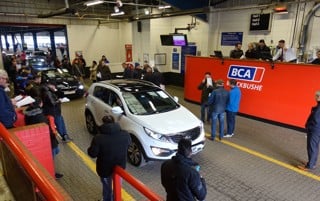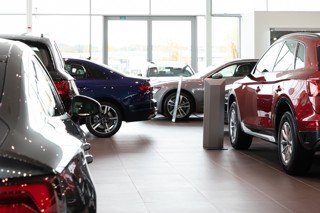With more attention turning to used cars as new car registrations decline, the profitability of the used car operation will be under even more scrutiny.
Meanwhile, withused car transactions flat in Q2 and a little year-to-date growth compared to 2016 (source: SMMT) competition is set to become fierce.
Dealers should be looking for marginal gains to boost the bottom line, according to Alan Henson, head of sales and customer services at automotive data experts KeeResources. He said: “In a market
where margins are already fine, small variations in used car values have implications for purchasing, stock funding and retailing.”
Transparency
Trust and transparency are top of car buyers’ priorities, delivered through customer reviews and online tools such as part-exchange evaluation and finance calculators.
Nick King, Auto Trader’s insight director, said: “If I know my part-exchange price, have worked out my monthly payments and viewed multiple images and even watched a video, what’s to stop me booking a test drive or coming to buy that car? I don’t need to look at anything else because I have found the car I want and have all the information I need.”
Lisa Iannucci, director of dealer marketing at CarGurus, said: “Transparency should be at the centre of the car buying process. This is where the industry is going; those who embrace it will be the ones who will succeed in the long run.”
Pricing
King added: “Pricing to market could halve the time a car spends in stock. If you sell more cars, you make more money. The more cars you sell, the more reviews customers write, the more reviews you have, the more trust is created and it becomes a virtuous circle.”
Auto Trader figures show vehicles priced 100-101% of the market sell on average within 30-35 days compared to those which are not priced and stay in stock up to twice as long.
CarGurus operates a rating system which incorporates dealer reviews from customers, delivering a return on search based on price and reputation.
Iannucci said: “A great deal is not just about a fair price but the entire experience with a reputable dealer. If a car is a fair, good or great deal it will typically get more visibility.
“A small tweak in price can sometimes mean a car going from page three to the first page. Dealers can see where their car would appear on the site, so they have visibility and control to enable them to make more impact. For example, you can see that increasing a car’s price by £50 or £100 may not make a difference to its rating or ranking so dealers can maximise margins.”
Search
Carsnip, which launched in January and has 7,000 dealers live, is a dedicated vehicle search engine linking listings directly with the dealer as soon as a car buyer clicks. Its co-founder Stuart Noad said: “Research tells us you need nine touch points before someone goes on to touch your brand but dealers invariably spend money building other brands.
“Dealers need to be driving traffic to their own website so they can capture the email addresses and undertake their own retargeting as well as gathering the data for future analysis. At the moment, you may know someone is looking at an Audi A4, but you don’t know if they were searching for a four-door saloon.
“We are now seeing dealers undertaking a mix of marketing and engaging more digital experts who understand Google analytics. We are seeing a shift in how digital marketing is being managed, how the data is being analysed and a focus on driving more traffic to dealer websites.”
As a PPC-based model, dealers can pay to highlight their vehicle if it matches the search criteria,
Noad added: “One dealer in Essex sold a car after a Carsnip search and it cost just £1.46, whereas the average cost of advertising a car before it sells is £150.”
Video benefits
CitNOW’s research published in its Benchmarking Report revealed that 74% of buyers are more likely to buy if they’ve watched a video of the product, 80% of consumers are open to making a car purchase using video and more than one in 10 demand video before making a final purchase decision. CitNOW’s Web app product enables sales executives to shoot a video on their smartphone in 90 seconds and upload to an integrated website or third party so the video is online in minutes.
Alistair Horsburgh, chief executive of CitNOW, said: “Dealer groups who use our Web to get their stock online have been able to shave up to two weeks off the amount of time a car spends on the forecourt. It is
important for sales executives to make sure they are using the full power of video to ensure they get an appointment with potential buyers.”
Stock management
Stock management including sourcing and disposal is vital if small gains are to be realised.
Powell said: “We see a continuing increase in used car sales activity continuing into Q4 and on into Q1 2018. However, it is not all plain sailing and dealers would be wise to assess their approach to used car inventory management.
“Dealers can work to bring stock to market quicker, making it available online the moment it is purchased, even if preparation time is required. An increase in inventory transparency can help the bottom line. The opportunity to grow used car sales is on offer right now.”
Conscientious buyers do their research, agree a bidding strategy prior to the sale and will even price up any necessary repairs.
Alex Wright, managing director, of Shoreham Vehicle Auctions, said: “The buyer that does more research and preparation before buying used cars for stock will be the winner at the end of the month/quarter/year.
“Hard-working buyers are those that earn a little luck along the way because of their sale preparation and are likely to get a couple of bargains at each sale they attend. Preparation meets opportunity and ultimately profit.”
When sourcing vehicles, Martin Potter, Aston Barclay’s group operations director, recommends working with the auction provider to assess damage prior to bidding and even have the damage repaired on site so it’s retail ready. With cars graded 1-3 receiving the most competitive bidding, dealers with refurbishment facilities can consider lower priced grade 3 and 4 stock which also attracts fewer bidders, potentially enjoying higher margins.
Adopting a group-wide remarketing strategy saw one dealer group benefit from a 1,000% increase in profitability, Potter said. Last year, following the March new registration, Aston Barclay collected, inspected and sold vehicles from leading dealer groups at their Chelmsford site, in under 48 hours.
Potter added: “Selling part-exchanges quickly after receiving them on site not only helps turn metal into cash quickly, it also ensures that used cars aren’t adding extra congestion to a site.”
More information
Doing your homework, though, extends to the market itself, Neil Gilligan, national business development manager, of INDICATA, online remarketing company Autorola’s new market insight tool, said: “Every used car business now aims to increase its stock turn and maximise the use of spaces on its forecourts. Basically, the more stock they sell more quickly will immediately increase their profitability.”
Providing key information on a site’s or group’s stock, INDICATA scours its own data to compare each vehicle’s age and price to same or similar competing vehicles and helps dealers identify in demand stock.
“Dealers can then determine whether their stock is over or under-priced, enabling them to fine-tune price and speed up a sale,” added Gilligan.
Henson said: “More subtle opportunities can be realised in the way cars are both bought and marketed by recognising and leveraging the increasing product ranges being made available by manufacturers, and the variations in specifications that can make a car more, or less, attractive. Nuances in specification are often being overlooked by valuation processes that cover cars on a broad-brush approach. Yet, real vehicle accuracy is available. Dealers can gain by having access to high precision, granular, details.”
Selling online
Online provides dealers with a largely untapped opportunity to boost used car profitability, according to James Tew, CEO at iVendi, who said: “Our analysis suggests where customers are given the opportunity, a significant proportion will complete as much of the sale online as possible.”
Of a sample of 12,500 motor finance transactions handled through the iVendi platform, 35% were sold without any need for any dealer contact – requiring no part exchange, being sold at the vehicle’s windscreen price and using the dealer’s online finance. Around one in 20 were fundamentally completed entirely online already, with no contact with the dealer until the final step, when the car was collected or delivered.
Added Tew: “The purchase usually continues on a trust basis until the final step, when the customer sees the car or van and can assess that it meets the dealer’s description. If the dealer provides the means for customers to choose and finance a vehicle online, a significant proportion will happily buy a vehicle in this way.”
PCP for used vehicles
Finance software providers Sword Apak reports increased used car sales activity this year as consumers look for value. James Powell, executive vice president, said: “It is also a reflection of the affordability on offer through the increased availability of PCP finance in the used sector. To an extent, the growth in used sales has reversed the activity that saw new sales increase when used car PCPs were not widely available.”
Add-ons
An obvious revenue stream is add-ons, with products like the extended warranty and service plans providing both upsell and customer retention opportunities. As more and more new car practices are adapted for the used market, dealers need to consider offering all-in packages. Supagard designs sales material for used vehicles and has no age or mileage restrictions which, like new, can become an intrinsic part of the used vehicle sales process.
Head of sales Alan Graham said: “A used vehicle to a customer is still their new vehicle, so the chances are that they will be keen to protect the finish. The customer can still very much enjoy the same benefits as a new car customer.”
Graham also recommends highlighting any negatives of the part-exchange vehicle which may have been reduced with paint protection: “Ensure all sales executives are well versed on the key elements on the part-exchange and how to use them as opportunities to build value in the concept of protection on the vehicle the customer purchases.”
ROI
Measurement and continual tracking to understand customer outcomes to improve ROI is a must and for Iannucci, the best way to track ROI is through the CRM. She said: “We have seen dealers who are tracking their digital marketing investments across multiple channels are able to
optimise their spend and improve their marketing ROI considerably better than those who don’t.”
Mark Lavery, chief executive, Cambria Automobiles: ‘We have to move with the market’
 After sourcing the right stock, at Cambria a military-style operation kicks into action which sees all teams working together for the car to be on the forecourt within 48 hours. A minimum of 20 images and an omnichannel approach maximises the chances of it being sold in 21 days, Cambria’s current average across the group’s 1,600 used car inventory, which equates to a stock turn of around 16 times a year.
After sourcing the right stock, at Cambria a military-style operation kicks into action which sees all teams working together for the car to be on the forecourt within 48 hours. A minimum of 20 images and an omnichannel approach maximises the chances of it being sold in 21 days, Cambria’s current average across the group’s 1,600 used car inventory, which equates to a stock turn of around 16 times a year.
Chief executive Mark Lavery wants to reduce it to 20 days, but highlights the industry’s recommended 48 days, with an average of 55 – a stark comparison.
He said: “The critical moment is appraising the vehicle thoroughly, assessing the potential recondition work and making sure the car is in the workshop diary. It could be the difference between a reconditioning bill of £200 and £1,500, and that can wipe your margin out completely.
“Most cars go into the diary system and will still be hanging around seven or eight days later, but you are best offering it up for sale as soon as possible as there’s one thing for certain – that car will depreciate. The only question is how much and how fast.”
At least 20 pictures and a full description are essential, said Lavery: “Don’t assume the guest knows the standard equipment such as air conditioning and electric windows. You need to tell the car’s story so the guest clicks for more information.
“Once you have the click and contact, it’s then making sure you respond within minutes, not hours. A car buyer may put in seven enquiries at the same time; they won’t be just contacting you, and there are two sorts of dealers – the quick or the dead.”
The group’s average response time of two minutes and 39 seconds for email and telephone enquiries is aided by technology which alerts a sales executives to make contact.
“As long as the response is good and quick, we will have an opportunity to attempt to transact,” said Lavery.
However, Lavery acknowledges the second and third follow-up if the consumer isn’t ready to visit immediately after the initial enquiry is the group’s biggest weakness, which is being addressed with training.
“It’s not about the old-fashioned techniques of closing. Customers don’t put up with that sort of thing any more. We listen to the calls so we can see where the errors are – we need to ensure we are providing as much information to the guest as possible about the product,” said Lavery.
To ensure a vehicle is priced absolutely to the market, Cambria’s sales executives look at the price every day.
Lavery said: “If the market moves, we have to move with the market. It could be as little as £100 in a week. If it’s above 20 days you have to do something and if it means you don’t get all the margin, that’s fine.
“If a car gets to 45 days and it’s a great big loss, then accept it and work out the reasons why and you have a better chance of getting it right than if you keep running away from it.”
Even with latest figures putting ROI at 138%, which Lavery compares to an industry average of 69%, he would like to see that at 145-150% ROI against used car investment.
He added: “I think we are miles off and there’s loads more we can do. It’s taken us three and a half years since 2013/14 to get here. Consumers want instant gratification and if you don’t provide that, they will vote with their finger.”
Debbie Kirlew



















Login to comment
Comments
No comments have been made yet.